January News 2024
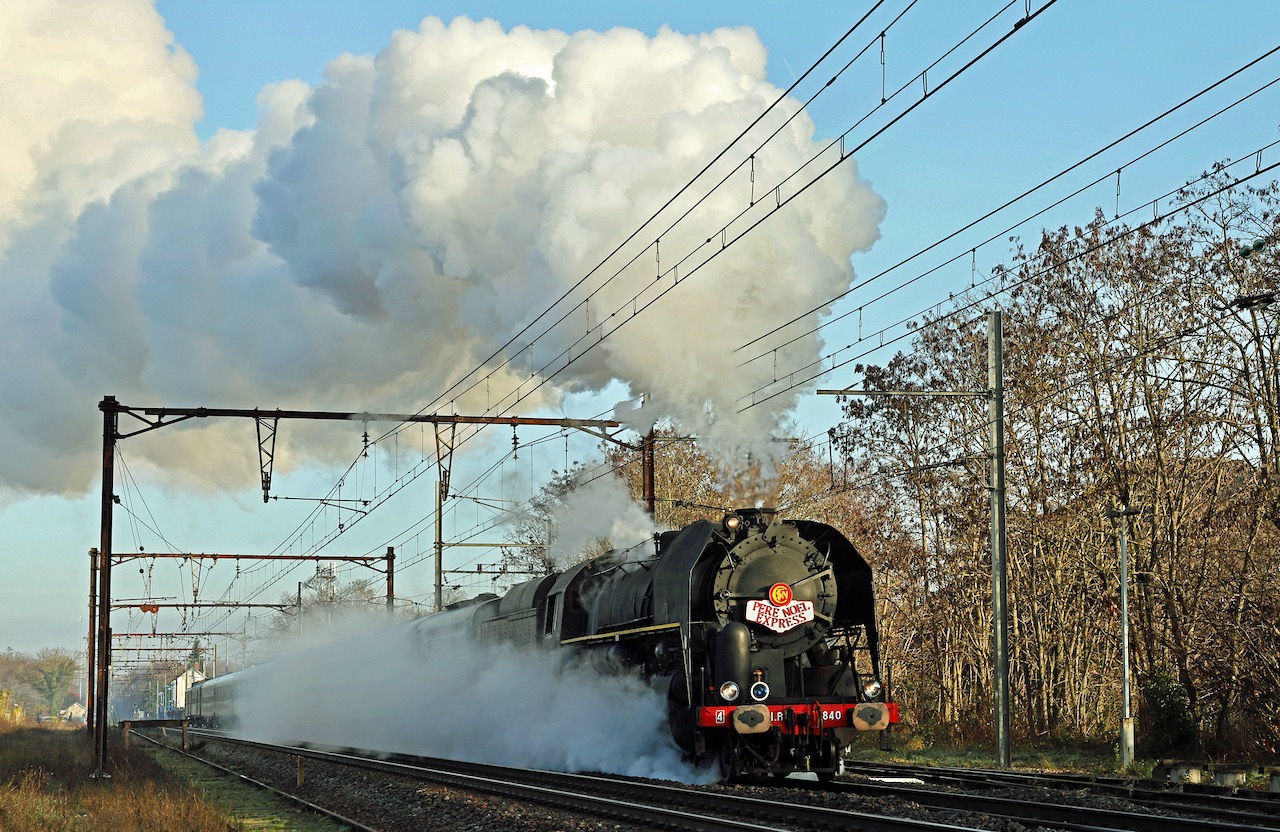
Joyeux Noël et Bonne Année
Season's greetings to all our readers and contributors
Season's greetings to all our readers and contributors
141 R 840 heads away from St-Cyr-en-Val on Saturday 16th December with a Christmas special from Les Aubrais to Bourges.
Photo: Jocelyne Bourneuf

Postal Museum on the move. BB 67610 heading towards Gaillac between Montastruc-la-Conseillère and Roquesérière-Buzeton on 28th November with former postal vehicles PA 50 87 00-77 005, PEz 50 87 00-77 719 and PEz 50 87 00-77 586 in tow. See report below.
Photo: Georges Turpin.
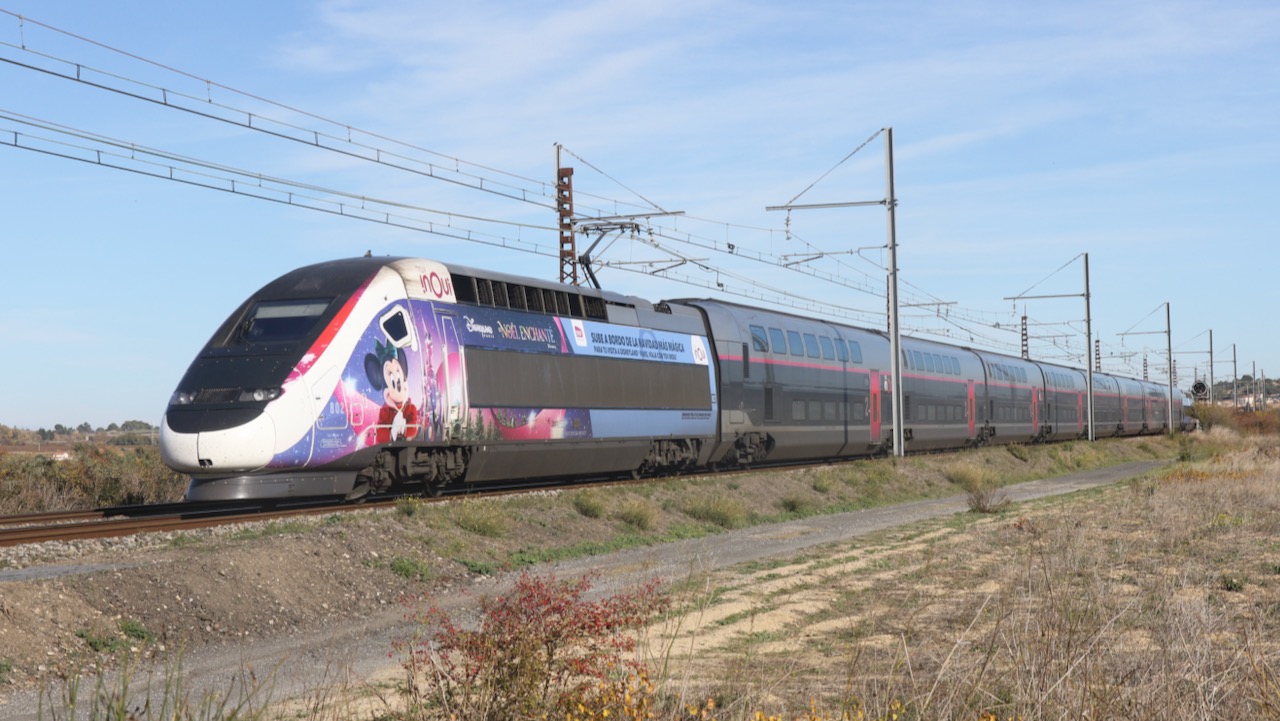
The power cars of Duplex TGV 802 has been repainted with a seasonal Disneyland Noël enchanté livery, Seen between Nissan and Coursan (between Béziers and Narbonne) with Train 9713 Paris Gare de Lyon – Barcelona Sants on 18th November. Photo: Georges Turpin.
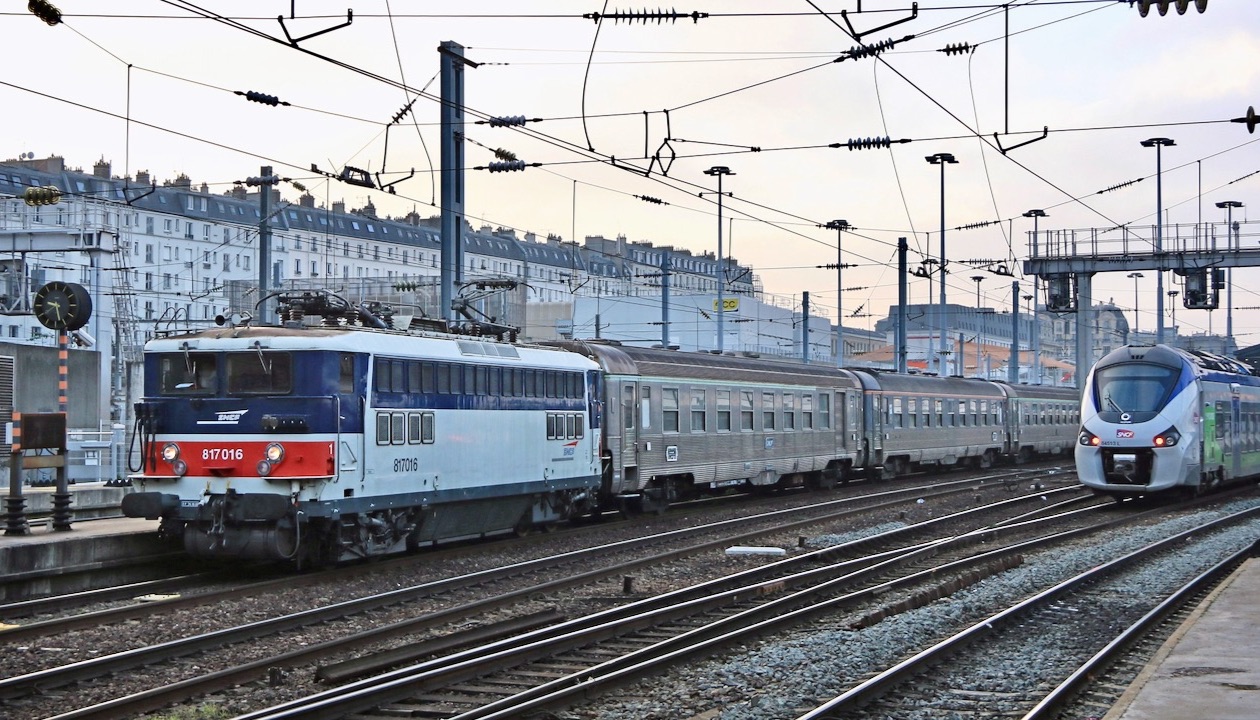
Class BB 17000 returned to Gare du Nord on 5th December when BB 17016 provided the motive power for the AAPSL (l'Amicale des Agents de Paris Saint-Lazare) Ch'ti train de Noël formed of MFPN's DEV Inox coaches. Of particular interest was the inclusion of the first vehicle, a B6 1/2Dtj, one of only four DEVs built with a van section; the other three were scrapped in the 1990s. Photo: Christophe Masse.
Maurienne Valley line expected to be closed for year
The bulk of the landslide (about 12,000 m3) fell on the roof of the Breche Gallery, a weight far in excess of its design limits, raising concern that it may collapse at any time, or be severely damaged.
Before work can commence on clearing the rubble and repairing the line, about 5,000 m3 of unstable material needs to be purged from the cliff. During October helicopters dumped water on the cliff on two occasions with little success. Explosives were used over the weekend of 11/12th November bringing down a further 1,000 m3. Experts believe that the cliff face remains unstable and fragile and it will take until the summer of 2024 to make safe. Only when the cliff has been completely secured and geotechnical assessments have been carried can work start on removing the rubble, installing further protection and strengthening the gallery.
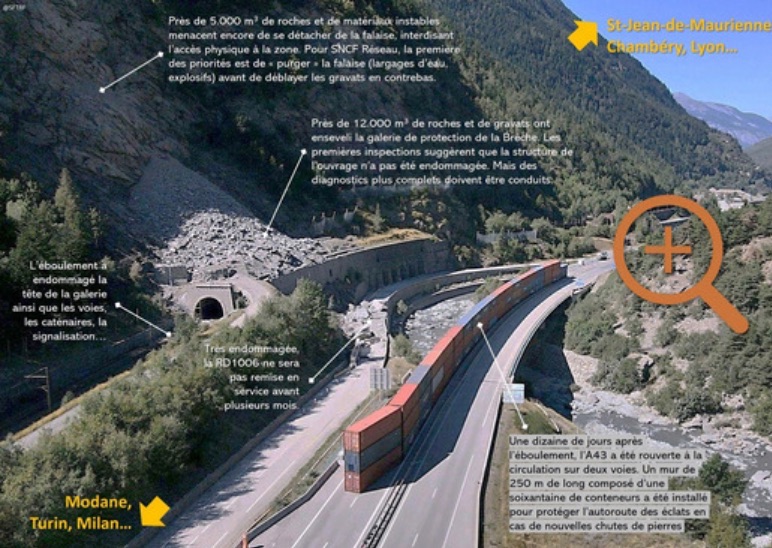
There is increasing pressure from authorities on both sides of the border to re-open the line as soon as possible. The line carries 2.7m tonnes of cross-border freight, and about a million passengers between Lyon and Turin annually. For Ambrogio Intermodal, the main Italian operator of rail freight between Spain, France and Italy traffic is now having to be diverted via Paris and Switzerland, where there is limited capacity due to the derailment in the Gotthard Base Tunnel, that is not expected to be repaired until next year.
SNCF Voyageurs will introduce a bespoke daily return service from the 10th January operating a TGV from Paris and Lyon to Saint-Jean-de-Maurienne. From here passengers will be transferred by coach to Oulx on the Italian side, and reboard a train to Turin and Milan. This will add about 90 minutes to the journey, but will avoid passengers having to travel via Nice or Switzerland with changes between operators.

First Transdev Omneo Premium for Marseille – Nice unveiled
On 23rd November Alstom unveiled its Omneo Sud variant under construction for Sud Provence-Alpes-Côte-d’Azur Region’s Marseille – Toulon – Nice line. To be operated by Transdev from 2025, this will be the first TER service run by a company other than SNCF. Originally placed with Bombardier, the €250 million order is for 16 eight-car double-deck EMUs with high standards of comfort, two classes of accommodation and a snack area. They will replace the BB 22200 locomotives and Corail stock currently operated by SNCF.
There are seats for 352 passengers, plus a further 49 folding for short-distance use, space for 12 cycles and fully-accessible toilets. Other amenities include innovative systems for video-surveillance, seat and cycle reservation, passenger counting and onboard wifi. Large windows and an open interior layout will give passengers wide views of the scenery en route. Transdev takes over operations on 29th June 2025, when the service will become hourly for most of the day (14 trains each way).
The EMUs are compatible with the ERTMS signalling which is currently being installed on the route for deployment from 2028, as well as with the parameters of the future Ligne Nouvelle Provence Côte d’Azur. Top speed is 200km/h. They will be maintained at a new depot being built at Nice St Roch. The first set left Crespin for the Velim test track in the Czech Republic, where four months of homologation tests started at the end of November. Photo: ©Alstom/Samuel Dhote.
Puy du Fou funding
Most of the route lies within the Vendée département which bought it in 1997. The project to ease road traffic congestion around the Puy de Fou site has been a local and regional aspiration for many years and figures in the Région/State Contract-Plan. Nevertheless, no other funding has been earmarked and it is unlikely that trains could be operating before 2030.
Running from Saint-Christophe-du-Bois on the Angers – Cholet – Clisson – (Nantes) line, the reopened route would have stations at Mortagne-sur-Sèvre, Saint-Laurent-sur-Sèvre, Les Epesses (close to the theme park) and Les Herbiers. The proposal envisages through trains from Angers offering connections with TGVs from Paris. Provision would be made for continuation of the steam service.
Opposite. A Chemin de fer de la Vendée service arriving at Les Herbiers on the 25th June 2023 hauled by SACM 030T 8143 (formerly No 6 of the chemin de fer de Mamers à Saint-Calais)
Photo: Georges Turpin.
Opposite. A Chemin de fer de la Vendée service arriving at Les Herbiers on the 25th June 2023 hauled by SACM 030T 8143 (formerly No 6 of the chemin de fer de Mamers à Saint-Calais)
Photo: Georges Turpin.
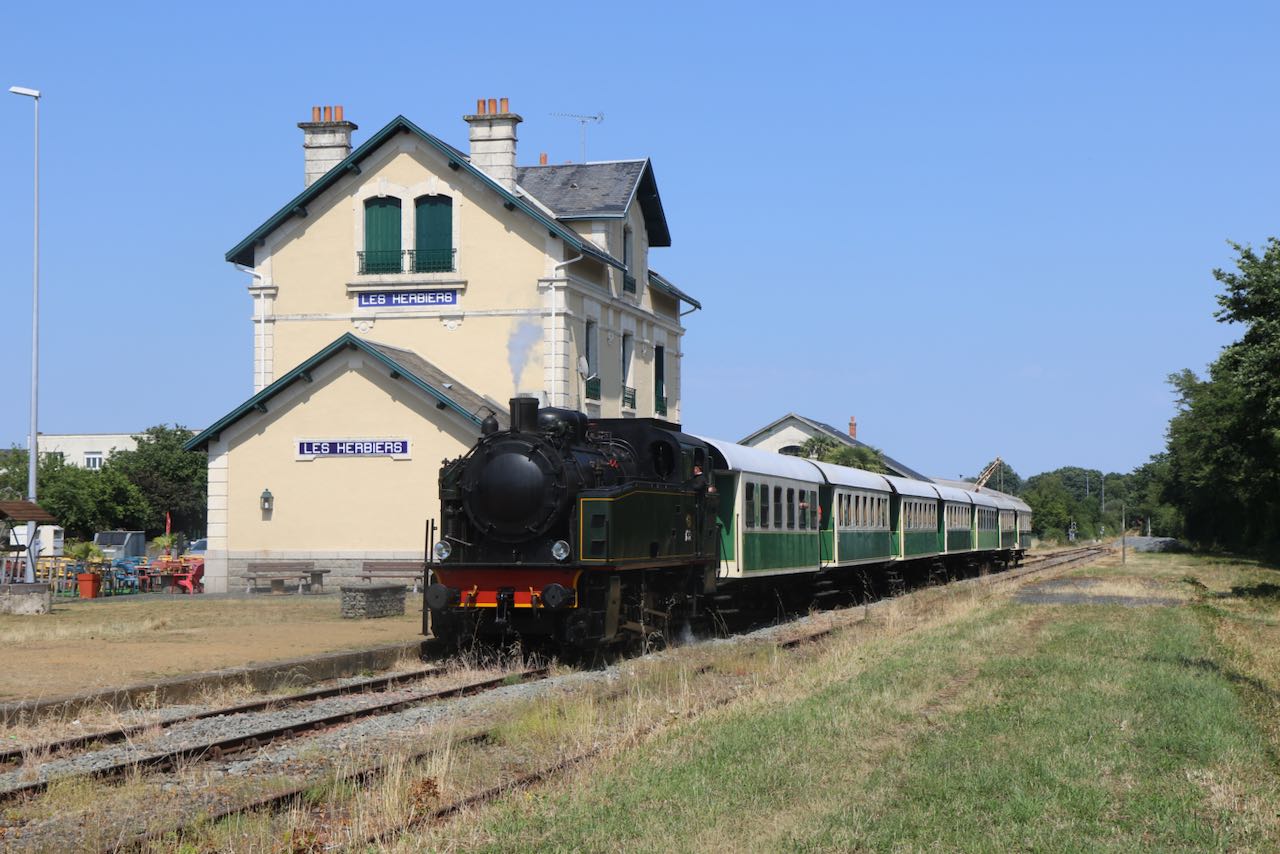
Thouars – Niort reopened
In addition, Amaltis at Parthenay will receive trains of fertiliser from Germany once or twice a month, while 2026 could see a flow of imported clinker moving from Sète to Val de Loire Ciments’ new works at Montreuil-Bellay north of Thouars. Other potential traffic could include resumption of cereals movement for export from La Rochelle and cement from the Calcia plant at Airvault.
Restoration as a through route has long been part of Nouvelle-Aquitaine’s freight strategy and the région would also like to see the line available for diversions in the event of disruption between Tours, Poitiers and Bordeaux, but the rudimentary signalling makes this unlikely, and there are no passing places between Saint-Varent and Niort. Reopening between Niort and Parthenay in 2019 gave a boost to the current project which involved partial renewal of the track with 25,000 new sleepers, upgrading bridges and drainage, modernisation of three level crossings, and simplification of track and signalling; the route is now effectively a single block section. Maximum speed is 60km/h. Total cost was €16 million, of which 44% was financed by the region, with small contributions from Carrières Roy and Amaltis.
Nice airport station
Nice Saint-Augustin station is to be redeveloped as Nice-Aéroport, becoming a multimodal interchange between air, TGV, TER, tram and bus services as well as private cars and cycles. Refurbished in 2022 with temporary buildings, Saint-Augustin will be rebuilt to a striking design described as Europe’s first gare bioclimatique to make the best use of heat and heavier rainfall caused by global warming, and with a low-emission footprint.
The huge roof in timber and low-carbon concrete will be equipped with pv panels capable of generating 600mW of electric power. Open sides will allow maximum heat-dissipation and the 4,200m2 of gardens will be irrigated by recovered rainwater. There will be 1,500m2 of commercial space and a 600m2 passenger hall above platform level; the bus station will be served by local and regional routes, and there will be parking for 700 cars and 900 cycles.
Construction starts in 2025 for completion by 2028. Two new platforms are to be built to accommodate TGVs, with space for two more when the Provence Côte-d-Azur LGV opens in the 2040s. By then, the existing line along the coast to Vintimille will have been upgraded and equipped with ERTMS to allow through running to Genoa and Milan by both French and Italian trains, making Aéroport an international station.
Nearby at Cagnes-sur-Mer, reopening of the racecourse station Hippodrome-Côte d’Azur has been proposed by the town’s maire. Opened in 1970 but unused for many years, this stop west of Cagnes station could provide valuable extra capacity as local journeys are planned to quadruple under the Aéroport project.
Photos: AREP/jeudi Wang.
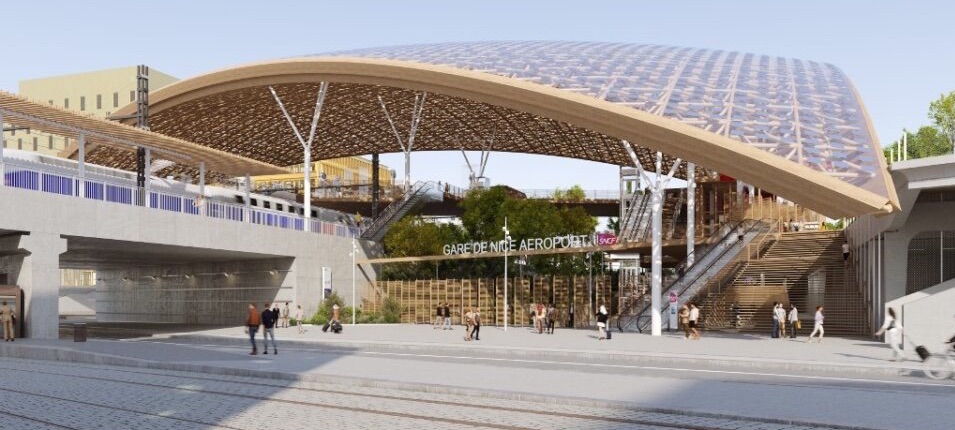

Laon – Hirson closed for three years
The 55km line from Laon to Hirson closed on 10th December for three years during which the line will be rebuilt. With a lack of maintenance over several decades the infrastructure is life expired and the line faces permanent closure. The work will cover replacement of all ballast sleepers and rails, renewal of 28 level crossings and repairs to 38 bridges.
Restoration of the line will cost a total of €93.3 million, financed 75% by Hauts-de-France région, 16.5% by the State and 8.5% by SNCF Réseau. Preparatory work will take place in 2024 with creation of the site bases and moving in ballast, sleepers and rail; most of the work will be carried out in 2025.
During the closure a replacement bus service will be provided with journey times extended from the 51 – 56min for trains to 1h 10min –1h 30 min depending on the stops. Fares on the replacement buses will be €1 or €10 a month.
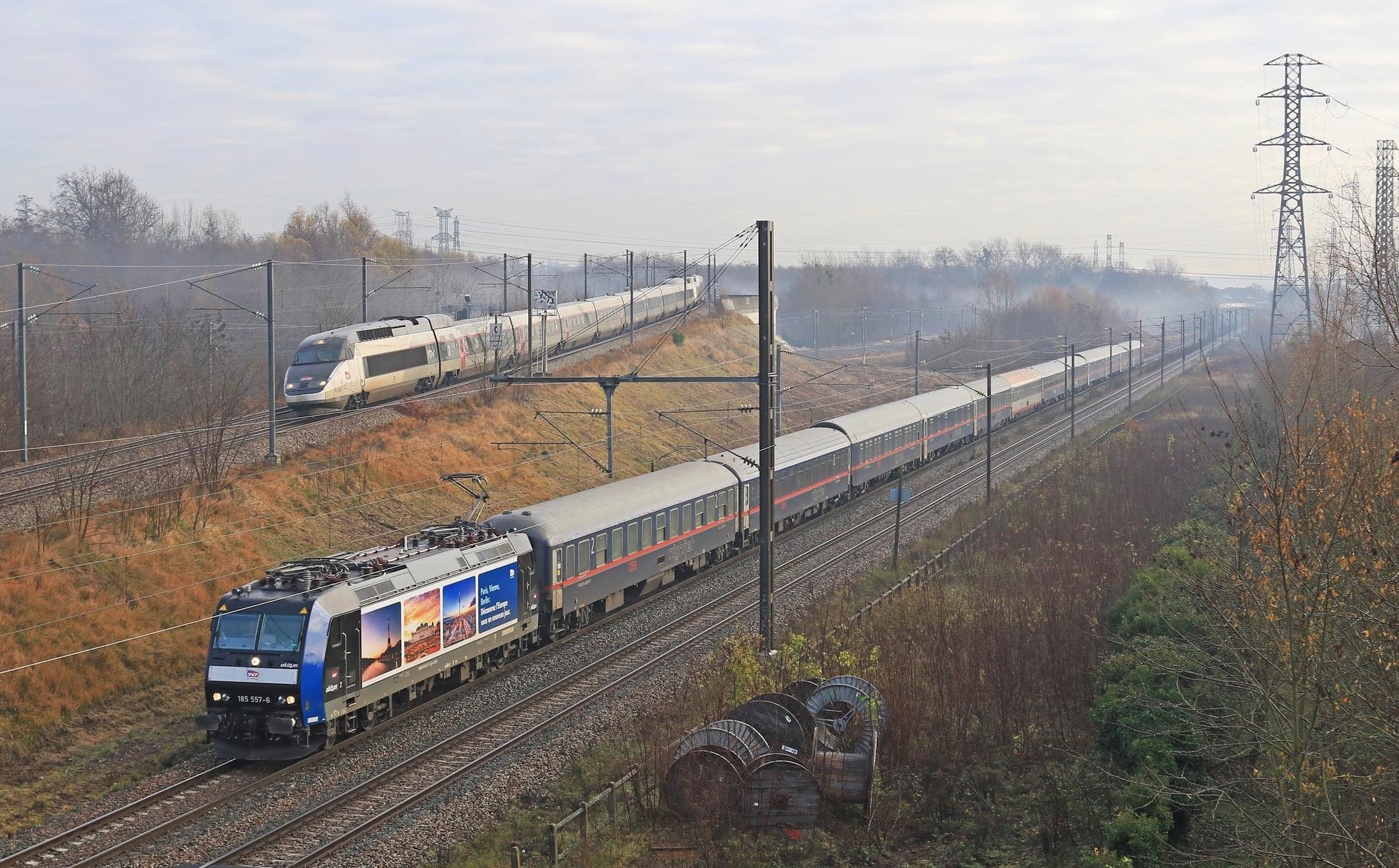
The new combined Vienna/Berlin – Paris Nightjet sleeper train (Vienna – Paris 468 and Berlin – Paris 40424) ran for the first time over the11/12th December. Traction through France is provided by Akiem (instead of MRCE who handled the Vienna train) with 185 557 specially decorated with side vinyls for the occasion. Currently running three times a week, it will operate daily from the autumn. On Saturday 16th December the Paris bound train is seen at Vaires-sur-Marne as TGV 2860 from Luxembourg overtakes as it descends the 'toboggan run' from LGV Est. Photo: Christophe Masse
Aurillac night train gets underway
SNCF were offering passengers heading to Aurillac an array of options on the afternoon of the 10th December. The new direct overnight service was €22, catch the Rodez portion (also attached to the 19.27) but change at Figeac and arrive in Aurillac at 07:15 was €74.60. If ready to depart earlier from Austerlitz on the 17:28, arrival could be achieved in Aurillac at 0.09 for €130.80 first class, although a better option might have been the 18.01 Bercy with the connection via Clermont Ferrand arriving at 23.56 for €95.90 or €110.90 first class. Another option is the 20.05 flight from Paris Orly arriving at Aurillac Tronquieres at 21.20 for €115. Surprisingly, the AURA TER timetable for Brive – Aurillac does not include the new night train, despite showing the other Paris connections.
Recent press reports indicate that there have been numerous cancellation on the overnight services to and from Rodez. According to the CGT at Rodez the train has been cancelled on 50 occasions since July due to locomotive failures and staff shortages.
The long layover at Brive for the Aurillac and Rodez services proved beneficial on the 15th December when BB 7305 failed at La Souterraine with a flashover. All passengers were disembarked, including those sleeping in couchettes, and taken to Brive by road in a fleet of five coaches. Here the Aurillac and Brive passengers were provided with a heated train to wait in, while a rescue locomotive recovered their train from La Souterraine. They were then re-embarked at 03.00 and still able to arrive at their destinations on time.
The Paris – Latour de Carol overnight train is now advertised for local travel on weekdays in the open carriage (voiture 14) between Toulouse and Foix only, departing Toulouse at 07.16. It is shown in the TER timetable as liO 871491.
Fret SNCF BB 67400 Farewell
The final scheduled working of Class BB 67400s by Fret SNCF took place on Monday 18th December with BB 67460/67471 on the Clermont-Ferrand – Saint-Chély-d’Apcher steel train. Surprisingly Fret SNCF published a notice giving details of the final working.
TBB 67400s have been retained on this service as their wheel profile is more sympathetic to the ancient track south of Neussargues that has precluded the use of Class BB 75000s. The services will now be worked by BB 60000s pending track renewal on which financial agreement between the state and regions has yet to be agreed.
The remaining FRET SNCF BB 67400 fleet (67460/471/494/503/559) were initially scheduled to be withdrawn on the 31st December, although 67460/471/494 have been sent to Brive to help out on the Rodez and Aurillac overnight services.
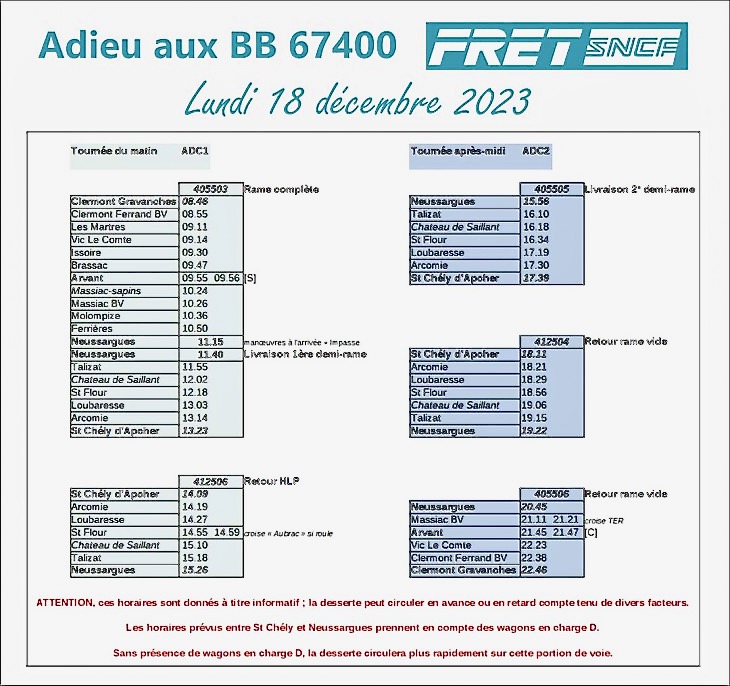
News in Brief
Eurostar joins AJC. Eurostar is to join CIT’s voluntary Agreement on Journey Continuation which allows passengers to reach their destination after they miss a booked connection due to delay or cancellation of a previous train. AJC covers cases where European or international legislation does not help, for example if passengers bought several different tickets for their journey, even from different sales channels or ticket providers. The conditions are that it is an international journey with separate transport contracts with each operator, and reasonable connecting times between trains.
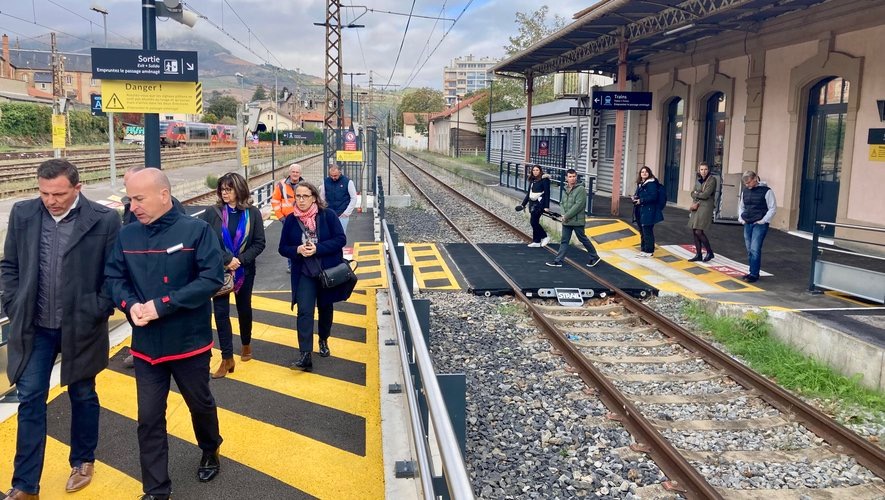
Millau refurbishment.A €3.4 million renovation of the main hall and platforms has recently been completed at Millau. Dating from 1874, the facilities were last refurbished in the 1970s. Work included improving the foot crossing to the main island platform which has been raised to 55cm to provide easier and safer access. Millau normally sees 40,000 passengers a year although services were disrupted last autumn while flood damage was repaired (see October News). Trains were expected to be running again between Bédarieux and Millau from 5th January, initially just once daily.
Photo: Midi Libre/F Mayet.
Trenitalia Paris – Lyon. From 10th December Trenitalia resumed operation of its five daily return Paris – Lyon trains, restoring services withdrawn after closure of the Maurienne Valley route last August (see item above). Until 21st April, two trains are extended to Chambéry at weekends.
Rugby results. In the 51 days of the Rugby World Cup which ended on 28th October, SNCF handled around 1 million extra travellers on TGV and a further 500,000 on Transilien lines in Île-de-France.
Amiens vandalism. Five Hauts-de-France TER trains were badly damaged by vandals on the night of 11/12th November. More than 200 windows were broken, onboard computer equipment smashed, and driving controls ripped out. Amiens – Paris and Paris – Compiègne – Saint-Quentin services were disrupted for several weeks whilst the trains were repaired.
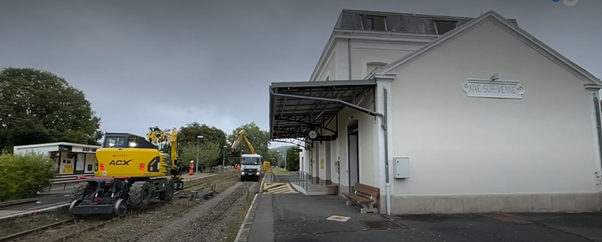
Angoulême – Limoges. Closed ‘temporarily’ between Angoulême and Saillat-Chassenon in 2018 because of the poor state of the track, this line could see upgrading work start in 2027 for reopening throughout by 2030. Limoges – Saillat trains resumed on 16th December after four months’ closure for relaying 10km of track between Limoges and Aixe-sur-Vienne at a cost of €9.9 million.Photo: France3 Limousin.
Abbeville – Le Tréport. Despite undertakings that reopening would be included in the new Région/State Contract-Plan signed on 23rd November, no funding has been earmarked for the project. Upgrading the 35km single track, estimated at €40 million on closure in 2018, is now costed by SNCF Réseau at €140 million, too substantial an increase for Hauts-de-France to fund its agreed 80% contribution. Studies are to be made into cheaper options.
Freight revival? Agglomération Concarneau Cornouaille is seeking to reopen the 7.4km electrified branch from Rosporden to grain silos at Coat-Conq (former line to Concarneau), last used in 2017, to serve an industrial zone and proposed intermodal hub. Currently goods destined for rail distribution must be carried by road to Rennes for transhipment.
Marseille yard changes. The yard at Canet which handles freight for Marseille and Bouches-du-Rhône is to close this year. Its work will be transferred to Mourepiane a few km north where a disused rail link into the Grand Port is to be reopened by 2026.
Fares please. Ouigo and Intercités fares are to be frozen for 2024, along with the cost of cartes avantages, transport minister Clément Beaune announced on 7th December. He also reaffirmed the commitment to launch before summer a national rail pass priced at around €49 a month for unlimited travel on TER and Intercités trains.
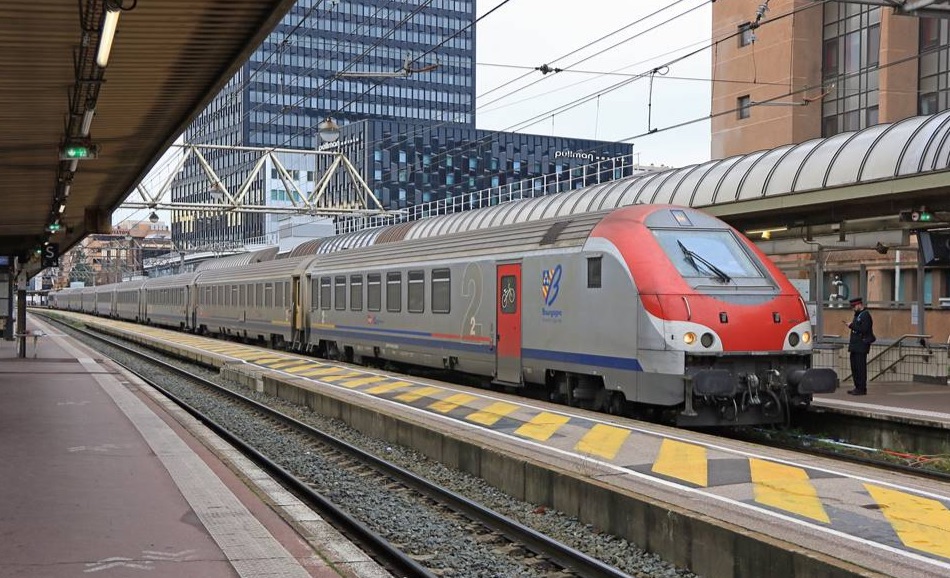
Loco-hauled Farewell. After 40 years the final locomotive and Corail Bourgogne Franche-Comté TER service between Lyon, Dijon and Paris ran on Saturday 9th December. Régiolis units took over all services from the new timetable. Photo Christophe Masse.
Catch ‘em young. A woman travelling on 07.01 La Ferté-Milon – Meaux (Transilien Line P) on 7th December gave birth to a baby girl on the platform at Meaux. As a result of suggestions on social media, the child was later granted a lifetime Navigo pass by Île-de-France Mobilités President Valérie Pécresse.
Télémédicine.SNCF plans to open Télémédicine centres at 300 stations by 2028 as part of a national effort to alleviate the shortage of doctors and medical facilities in deserts médicaux. Loxamed will supply 15 m2 modular buildings like those used for covid testing. They will be staffed by a nurse able to guide patients through a video consultation with a doctor. Medical professionals ridiculed the proposal, suggesting instead that improvements to rail services would help attract more medical staff to rural areas.
Bumper year for Vivarais. Le Mastrou enjoyed its best year ever in 2023 when 110,000 passengers were carried, and 49,000 took the velo-rail. However, the Ardèche was hit by violent storms in September and October causing landslides that have cost nearly €100,000 in damage to the track.
Rail theft. Three arrests have been made in connection with the theft in August of 566 tonnes of rail awaiting disposal at the old freight depot at Cahors. False documentation reportedly provided by a member of SNCF staff allowed the thieves to sell the scrap rail to a Spanish firm for €120,000; the material was intercepted en route.
Faster... In the timetable introduced on 10th December, France’s fastest timing is still a sprint between Champagne-Ardennes TGV and Lorraine TGV (see May 2023 News), now slightly faster at an average of 271.8km/h. The previous 37min timing has been restored for one train, TGV 5482 08.09 Nantes – Strasbourg.
. …and slower. Le Havre – Paris user groups have complained of further degradation of journey times, extended by up to 8min due to reconstruction of Rolleboise tunnel between Rosny-sur-Seine and Bonnières. Today’s best time is 2h 08 with one stop at Rouen, 21min slower than in 1969.
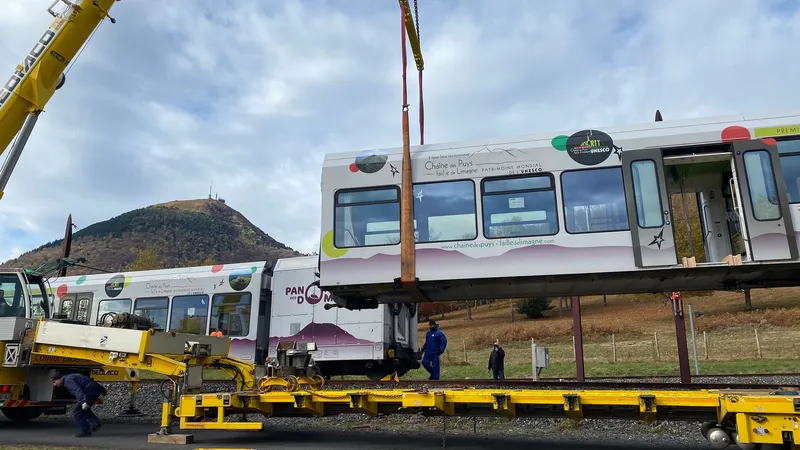
Puy-de-Dôme maintenance. This winter sees the fourth Panoramique des Dômes Stadler rack train undergoing heavy maintenance. At Orcines on 20th November the set was craned onto low-loaders for the journey to Clermont-Ferrand where ACCM and Stadler personnel will carry out six months’ work at a cost of €1 million. Photo: France.tv/Aurélie Albert.
Valdunes receivership. France’s last manufacturer of railway wheels and axles was placed in receivership on 20th November having failed to find a buyer (see October News). This allows work to continue on orders recently placed by SNCF, RATP and Alstom in an attempt to stave off bankruptcy. Valdunes’s owner, MA Steel, pulled its investment and put the company up for sale last summer.
Felletin. The branch from Busseau-sur-Creuse to Felletin (36km), stub end of the PO line that formerly ran to Ussel (closed 1979), has for years been served by only one or two daily trains and none at weekends. Fewer than two passengers a day were recorded in 2022. Since 10th December, Saturday trains are back, three running through to Limoges and two return. There is now also a Sunday service in both directions.
Nexon – Saint-Yrieix. Trains will run again from 9th February after eight months’ closure for reconstruction of 15km of track, replacement of 14 turnouts and renovation of three bridges, the €22.5 million cost funded 83.5% by Nouvelle-Aquitaine région. Line speed has been raised to 70km/h.
Perthus freight. The French and Spanish governments have discussed subsidising access to the Perthus tunnel route, where the current charge for freight passage ranges between €300 and €700. Spain wishes to make more use of its standard-gauge network to boost freight movement to the rest of Europe, whilst France would benefit from fewer lorries on the roads.
LGV delay. Start of the LGV four-tracking works at Castelnau-d’Estrétefonds north of Toulouse has been postponed until September due to the presence of European otters (Lutra lutra, a protected species) in the vallée de l’Hers and the Canal latéral de la Garonne close to the worksite.
Toulouse derailment. A works train derailed in Toulouse Matabiau station early on 26th November causing severe damage to the overhead, several points and other infrastructure. Remedial work was carried out overnight until all lines were reopened on 9th December.
Edinburgh sleeper. Plans for a Paris – Edinburgh night train have been shelved following revision of Midnight Trains’s aspirations for a Europe-wide network. The company will concentrate on the Paris – Mediterranean axis, with destinations including Nice, Milan, Venice, Florence, Rome, Barcelona and Madrid. German and Scandinavian routes have also been put on hold.
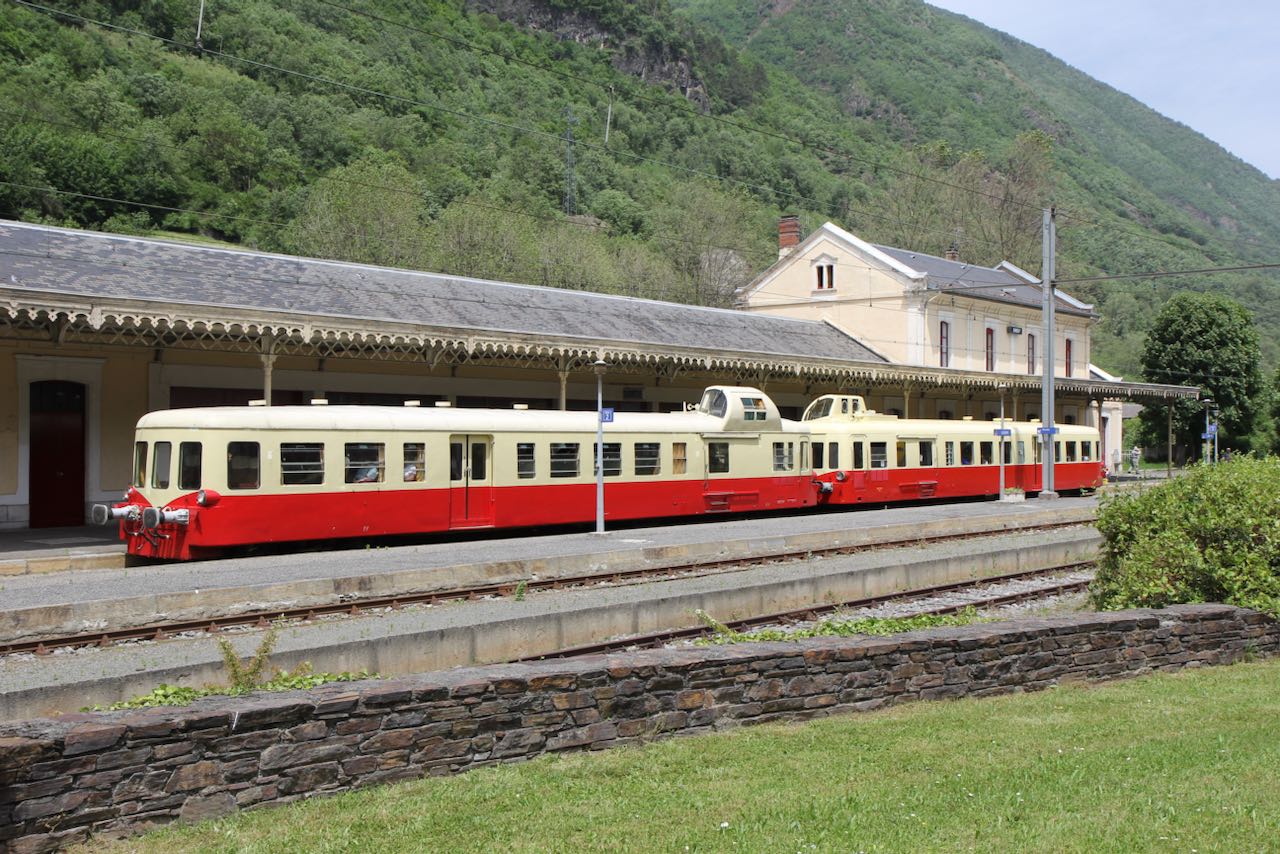
Luchon. Rehabilitation work costing €67 million started last month between Montréjeau and Luchon (36km). The line is scheduled to reopen in December 2024 with a DMU service of six return trains daily, journey time 35min. In 2025, the line will be the first to run with hydrogen-powered MUs. Above. Picassos X 3943 + X 4039 at Luchon in June 2013 with a special from Toulouse. Photo: Georges Turpin.
Troyes electrification. Preparatory works started on 8th December at Romilly-sur-Seine for electrification between Nogent-sur-Seine and Troyes (66km, 119 track-km), which is to be carried out during summer-long closures in 2025, 2026 and 2027.
Another solid year for CFBS. The Baie de Somme enjoyed another good year carrying almost 213,000 passengers. Although 1% down on 2022 the new velorail at Cayeux carried 9,600 cyclists
Another solid year for CFBS. The Baie de Somme enjoyed another good year carrying almost 213,000 passengers. Although 1% down on 2022 the new velorail at Cayeux carried 9,600 cyclists
Hybrid Régiolis enters commercial service
As can be seen from the photo opposite, the departure area was covered in green carpet and bathed in green light to signify the train’s environmental credentials; it then departed under diesel power. Photo: Georges Turpin.
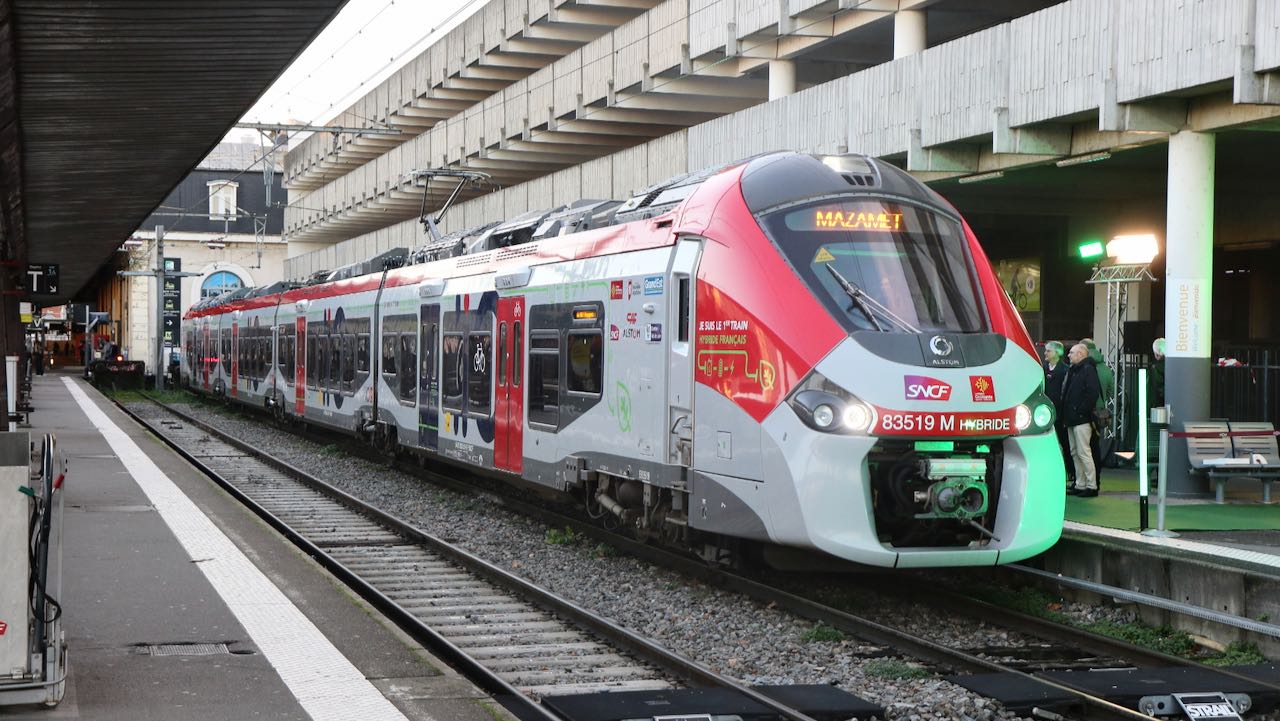
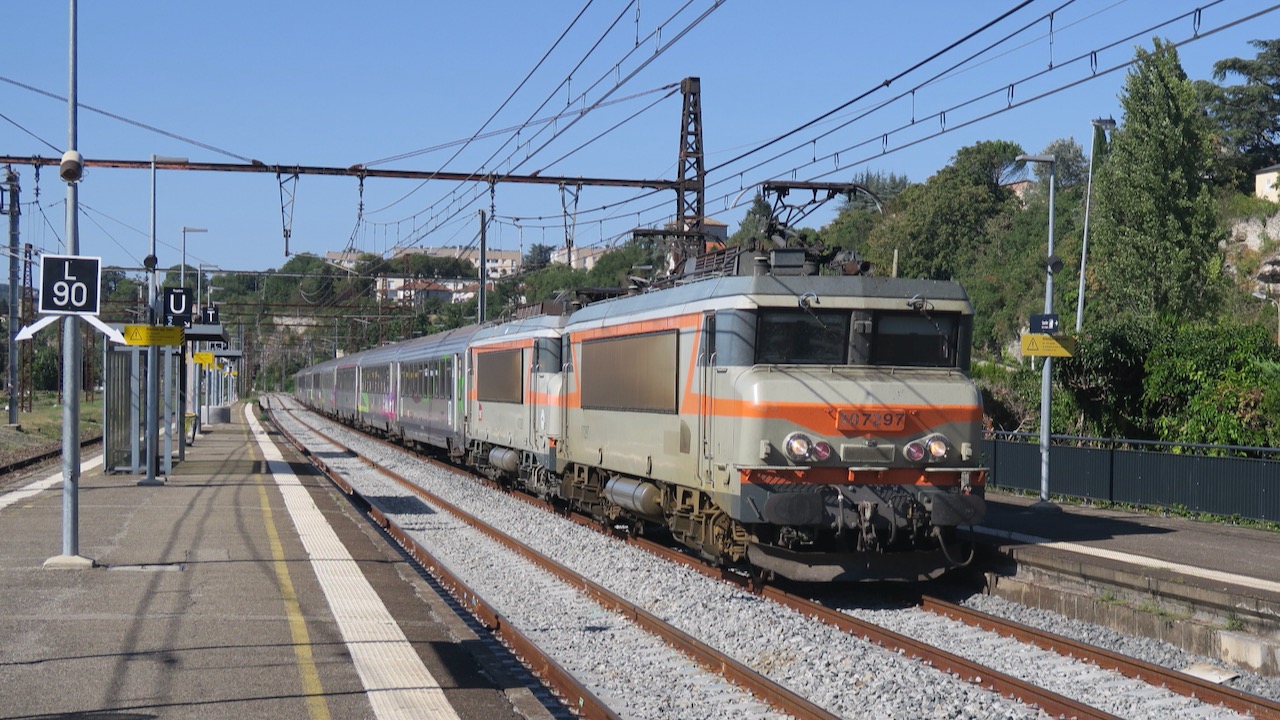
More Intercités funding
He unveiled three new financial agreements between the State and SNCF Réseau. Two cover provision of €13 million for additional works between Brétigny and Boisseaux (50km) and €8 million for studies to identify other work required between Les Aubrais and Montauban. The third is a grant of €17.5 million for improving the existing offer on the Clermont route whilst services are disrupted by ongoing rehabilitation. More effort will go into maintenance of the aged motive power and Corail coaches in the hope of improving reliability and punctuality. Onboard service is also to get a facelift.
A few days before, the Presidents of eight départements served by POLT had again called for urgent improvements in an open letter to the transport minister following a particularly bad run of delays and cancellations exacerbated by the atrocious weather in early-November (see December News). They seek a minimum of 10 trains each way daily with a Paris arrival earlier than 08.30, a quality-of-service charter and guaranteed refunds for delays, better cleaning of coach interiors, and more onboard personnel.
Above. Late afternoon on Saturday 9th September sees BB 7297 with 7282 dead in tow roll into Cahors with Train 3619 08.28 Paris - Toulouse running 150 mins late following an engine failure in the Paris area. This was a week of mixed running, on Monday 4th a rockfall at Mercuès had delayed services by over an hour, while on Tuesday 5th a lineside visit to photograph the 12.41 Paris – Cahors and 16.38 Toulouse – Paris found the southbound train running over two hours late and the northbound terminated at Montauban.

Foire du livre de Brive
Above and opposite. TGV 405 running into, and upon arrival at Brive. Photos: Christian Hospital.
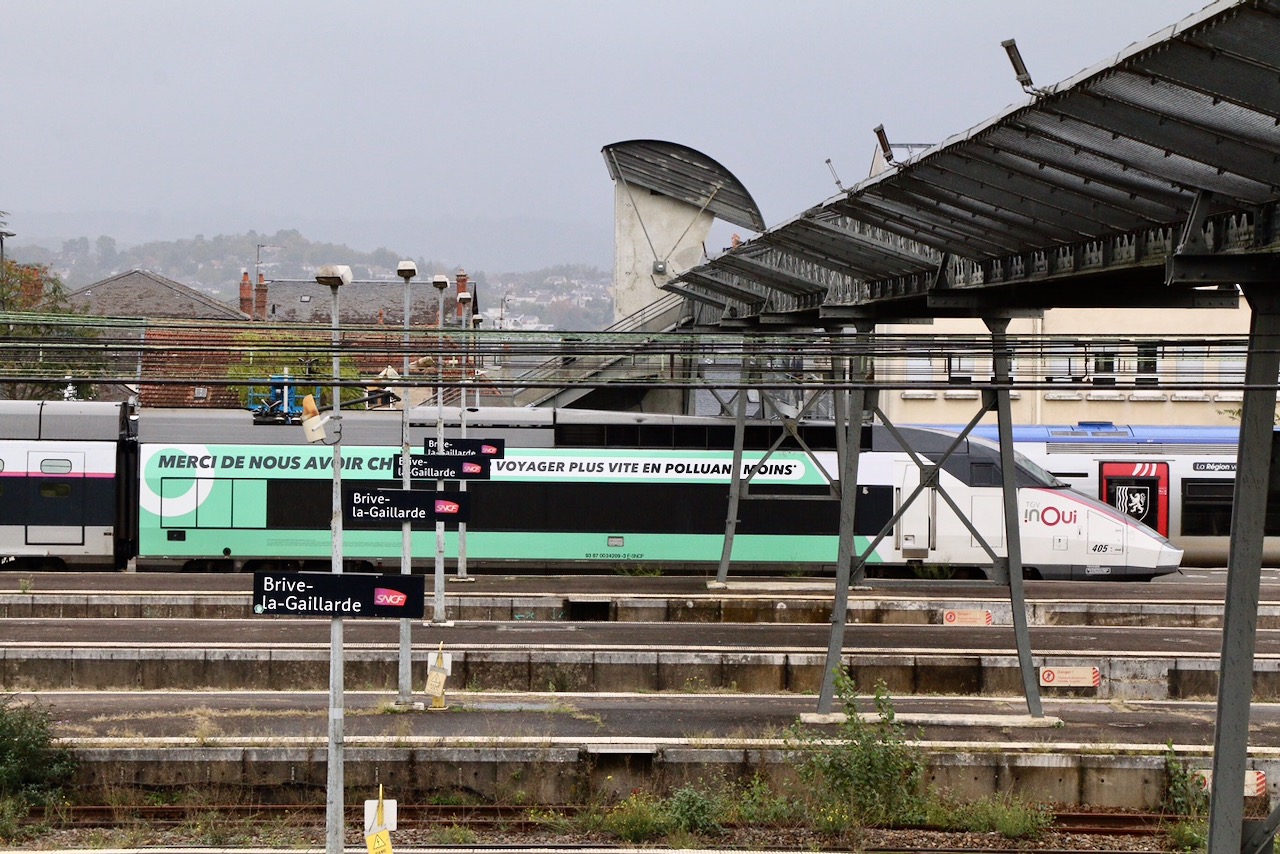

Rockfall closes ligne de Cévennes
A rockfall at Monistrol-d'Allier on 15th December has closed the ligne de Cévennes through the Gorges d'Allier. 150 m3 of rock fell on the trackbed moving it over a metre along a 70 metre stretch
SNCF anticipates that the line will be closed until 25th May while the cliff face is stabilised and secured before the line is cleared and repaired. A substitute bus service has been introduced between Langeac and Langogne, with connections to the intermediate stations at Chapeauroux, Alleyras and Monistrol-d'Allier by pre-booked taxi..
Photo: SNCF Réseau.
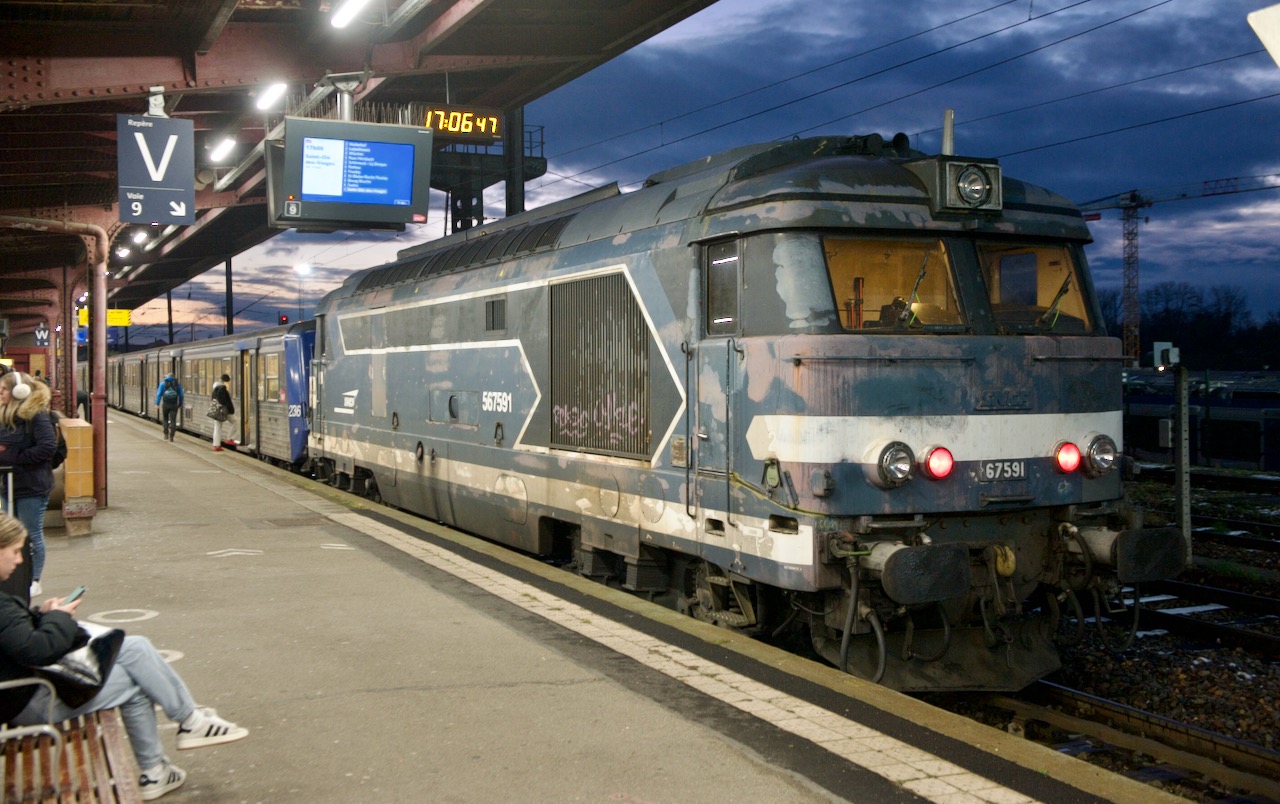
Variety in Alsace
Alsace's TER network, centred on Strasbourg and operated as part of Grand Est's Fluo transport system, provides one of the greatest varieties of rolling stock in France. It is now the only location operating three different types of locomotives with BB 22200s and BB 26000s working alongside the last regular BB 67400s. The 21st century is represented by X73500, a range of diesel, electric and bi-mode AGCs and four and six car Régiolis units. With a lot of the modern units transferred in from neighbouring areas for Strasbourg's attempt at an RER network Grand Est Fluo, Alsace, Metrolor (Lorraine) and Champagne Ardennes liveries are all on display.
The BB 67400s have three regular turns in the evening rush hour with push-pull RRR stock, although diesel units can also appear. The regular turns are the 16:20 to Lauterbourg, 17.06 to St Die and 18.14 to Saales, the latter two stabling overnight and returning the next morning. Above. On the 5th December a well worn BB 67591 waits to leave Strasbourg with the 17.06 to St Die. Entering service in 1974 this is the youngest of Strasbourg's BB 67400 fleet, the other examples dating from 1972.
The Grand Est fleet of BB 26000s were all introduced in 1994 and operate with push-pull Corail stock dating from 1975-85.
They are mainly deployed on the Strasbourg – Bâle 200km/h services, but also work to Nancy, Metz and Paris where they cover a couple of peak Paris – St Dizier services. It is possible to travel from Bâle to Paris loco - hauled without changing, by travelling on the 14.51 from Bâle, that upon arrival at Strasbourg pauses for a few minutes and goes forward as the 16.21 to Paris Est.
Opposite. BB 26145 pulls away from Bâle SBB with the 11.21 to Strasbourg on the 5th December leaving BB 26143 in the station. The first coach is one of the few in Fluo livery.
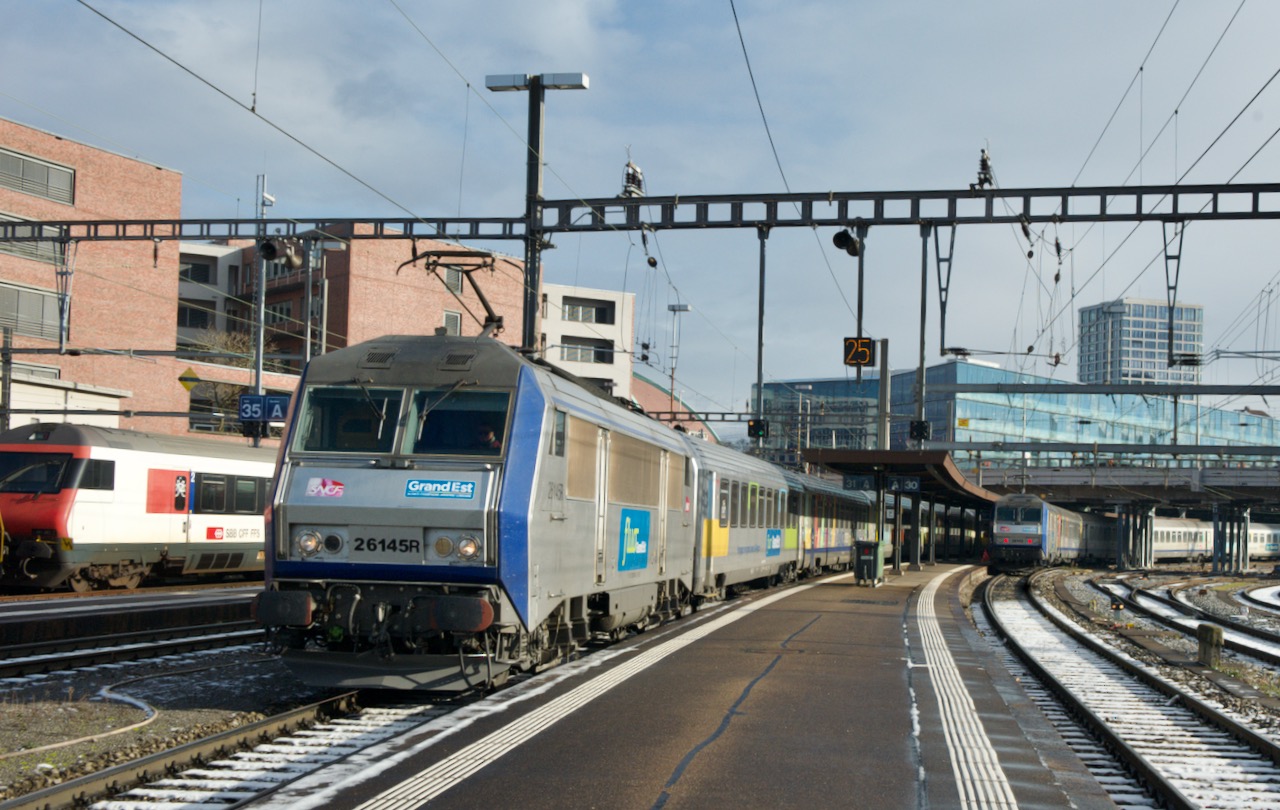
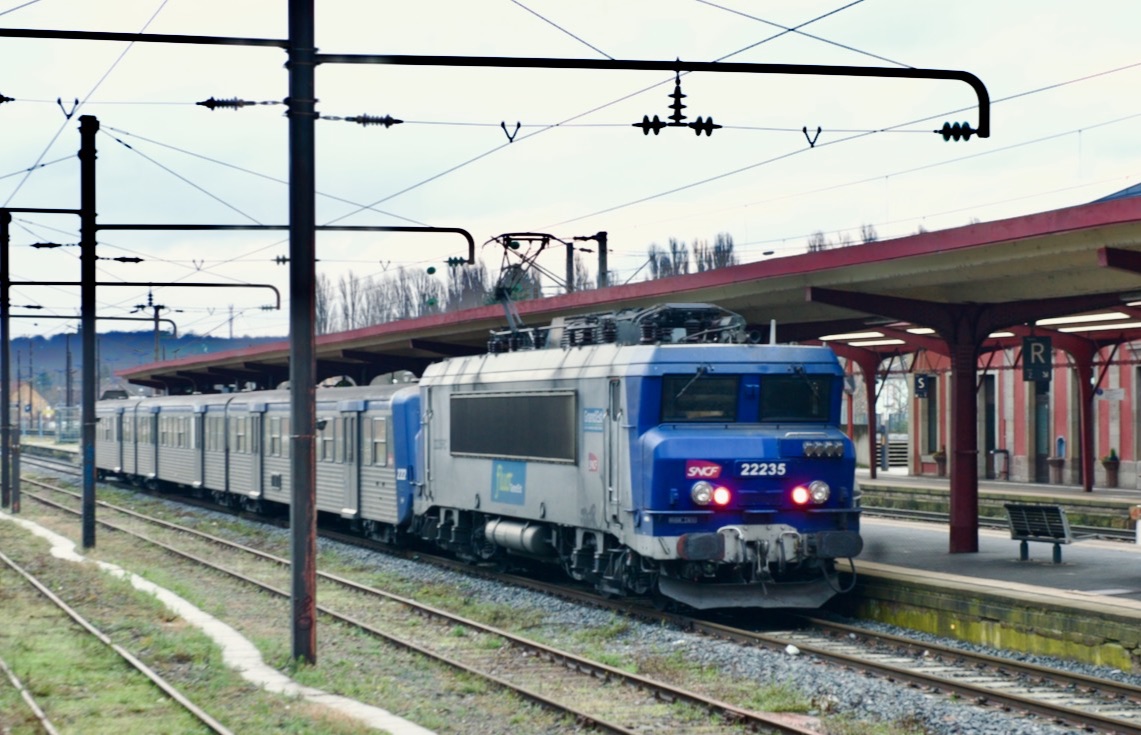
The BB 22200s and three car RRR push-pull sets operate the majority of the Saverne – Strasbourg – Selestat stopping trains with Régiolis units handling the remainder.
The RRR sets appear rather battered, but the refurbished interiors with 2+2 armchair seating and power sockets provide a good level of comfort for local travel. The single level also appears more spacious than the ramps and platform mounted seating of the Régiolis units. The most exhilarating feature is the acceleration a 5800 bhp locomotive can achieve with a 102 tonne RRR unit
Opposite. BB 22235 waits to leave Saverne with the 09.22 to Selestat on 6th December.
Serpent de Mer surfaces again
The Serpent de Mer, or the Ligne Nouvelle Paris Normandie (LNPN) to give it the official name, has attracted renewed attention following consultation between SNCF Réseau and local elected officials on the detail of the Évreux – Mantes section. The origins of the project go back to the early-1990s, when a map of future TGV lines showed an LGV Normandie. This was quickly abandoned on the basis that the benefits would not justify the cost. The concept rose again in the 2000s as a proposal to reduce congestion on the Paris – Rouen main line and in 2009 the government instructed Réseau Ferré de France to start initial studies
Designated an official project to build a 250km/h high-speed line in 2011, it is now managed by SNCF Réseau and has its own website The proposed line has four distinct sections, shown on the map opposite.
Progress to date on studies and public consultation prior to a declaration of public utility has been stop-start and a declaration is not expected until 2027-28. The first priority will be Paris –Nanterre – Mantes-la-Jolie and Rouen – Barentin, with the objective of putting these two sections into service after 2035 including a new Rouen station at Saint-Sever. These sections would increase capacity and reduce congestion. The second priority will be the Mantes – Évreux and Barentin – Yvetot sections to be completed after 2040.

There is limited enthusiasm for the new line from elected officials. President of the Île-de-France region Valérie Pécresse is opposed to the Paris – Mantes section on the grounds that the small saving in time does not justify the cost, estimated at over €1 billion for a 4min saving, and the money would be better spent upgrading the existing line. In the Eure département, officials are demanding that the new Evreux station should be in the town and not 'in the middle of nowhere'. Further north, officials complain of the project being imposed upon them and there is concern over the loss of buildings and agricultural land, and construction of a bridge 1km long and 30m high to span the River Eure.
Lyon Fête des Lumières
Lyon's annual La fête des Lumières took place from Thursday 7th to Sunday10th December with three special trains bringing in visitors to Lyon Perrache on Saturday 9th.
The first to arrive (see photo opposite) was X2816 with trailer XR6154 from Besançon operated by the Autorail X2800 du Haut-Doubs Association. The throaty roar of its Renault engine returned to Perrache as it made the customary run around its trailer before stabling in one of the bay platforms.


Following on was Train à Vapeur d’Auvergne - Association de la 141 R 420's special from Clermont-Ferrand. With 141 R 420 still not returned to traffic this was operated by their pair of RRR (Rames Réversibles Régionales) and a BB 67400. (opposite)
The final special was organised by APMFS from Chambery. Originally planned to be operated by CC 6558, this was unable to run due to high levels of humidity in the motors following heavy rain in Savoie. BB 22400 was provided as a last minute substitute.
Both photos: Christophe Masse.
Mohon roundhouse to be sold
SNCF has agreed to sell the roundhouse at Mohon to Les Ateliers de Vendeuvre who plan to use it to build containers and specialist wagons for heavy loads. In recent years it has been used to store exhibits from Cité du Train at Mulhouse, but there have been concerns over the poor condition of the building, with visits being prohibited due to safety concerns. Les Ateliers de Vendeuvre plan to restore, and will open it to the public for heritage and other events.
In a move co-ordinated by UNECTO (the umbrella organisation for French preservation societies) the Cité du Train exhibits previously stored at Mohon are being distributed to preservation organisations across France.On Saturday 9th December a special train hauled by BB 67556/67611 ran from Mohon to Arques where 23 D 9 was dropped off at CFTVA, before continuing to Sotteville with 150 P 13, an A6D Saucisson coach for PVC, and BB 16020, for onward transfer to AAPSL at Achères.
Opposite is a video of the transfer of 230 D 9 from Mohon to Arques produced by members of CFTVA.
Opposite is a video of the transfer of 230 D 9 from Mohon to Arques produced by members of CFTVA.
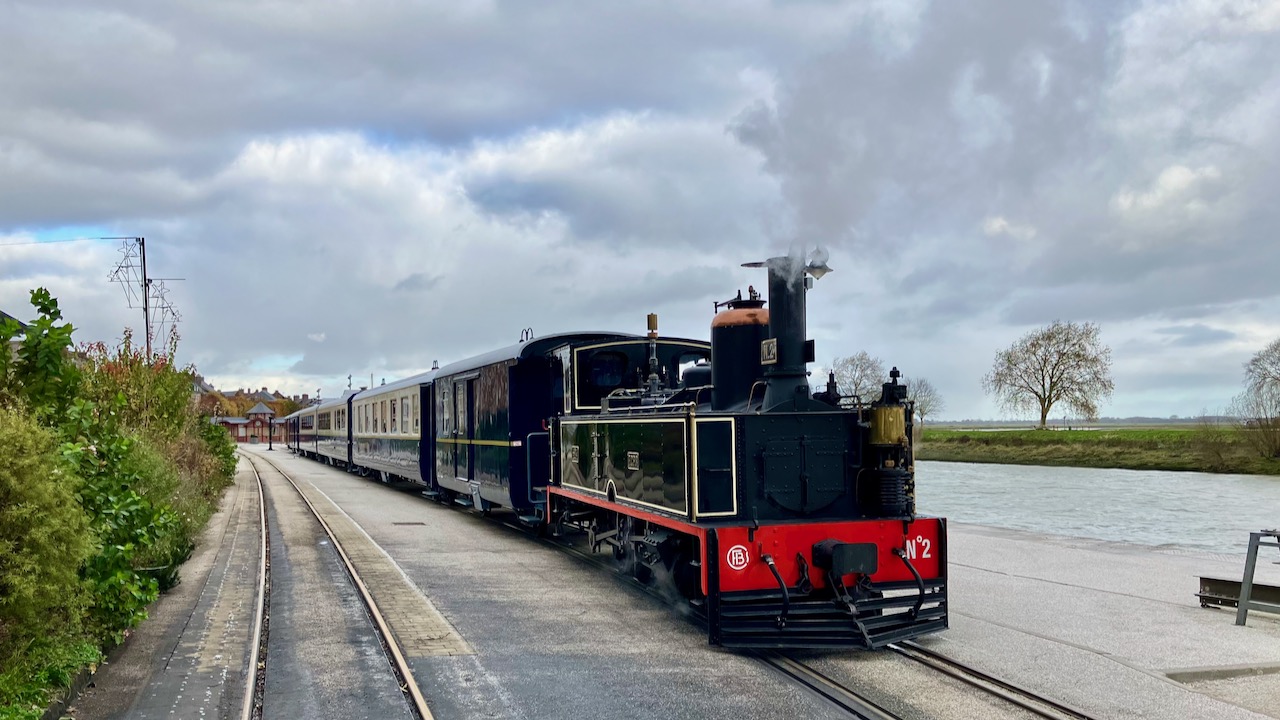
Inaugural run of CFBS Quatre Saisons dining train
In a ceremony attended by elected officials from the Hauts de France Region, the Somme Department and local mayors the inauguration of the CFBS's new Quatre Seasons dining train took place at St Valery on the 24th November, followed by lunch for the elected officials and guests during a run to Noyelles.
Using former RhB kitchen and dining vehicles dating from 1985, the train has taken five years to create by CFBS volunteers. The interiors has been completely renovated including the fitting of new windows. Significant work has also been undertaken on the electrical side, removing the equipment associated with the RhB's 11 kV AC overhead catenary and replacing with a diesel generator located in one of the forgons, necessitating alterations to the electrical systems to operate at a different voltage. Other work has included altering height of the buffer and couplings and adjusting the braking system to operate at the lower pressure required for the Baie of the Somme instead of the Alps.
With improved heating and lighting he new train provides a step change in passenger comfort and operating efficiency compared to the previous 'Diner Abord' train using 1920 wooden Somme coaches although diners will miss the opportunity to stand on the open balconies The new train will enable the dining train season to be extended from April until October.
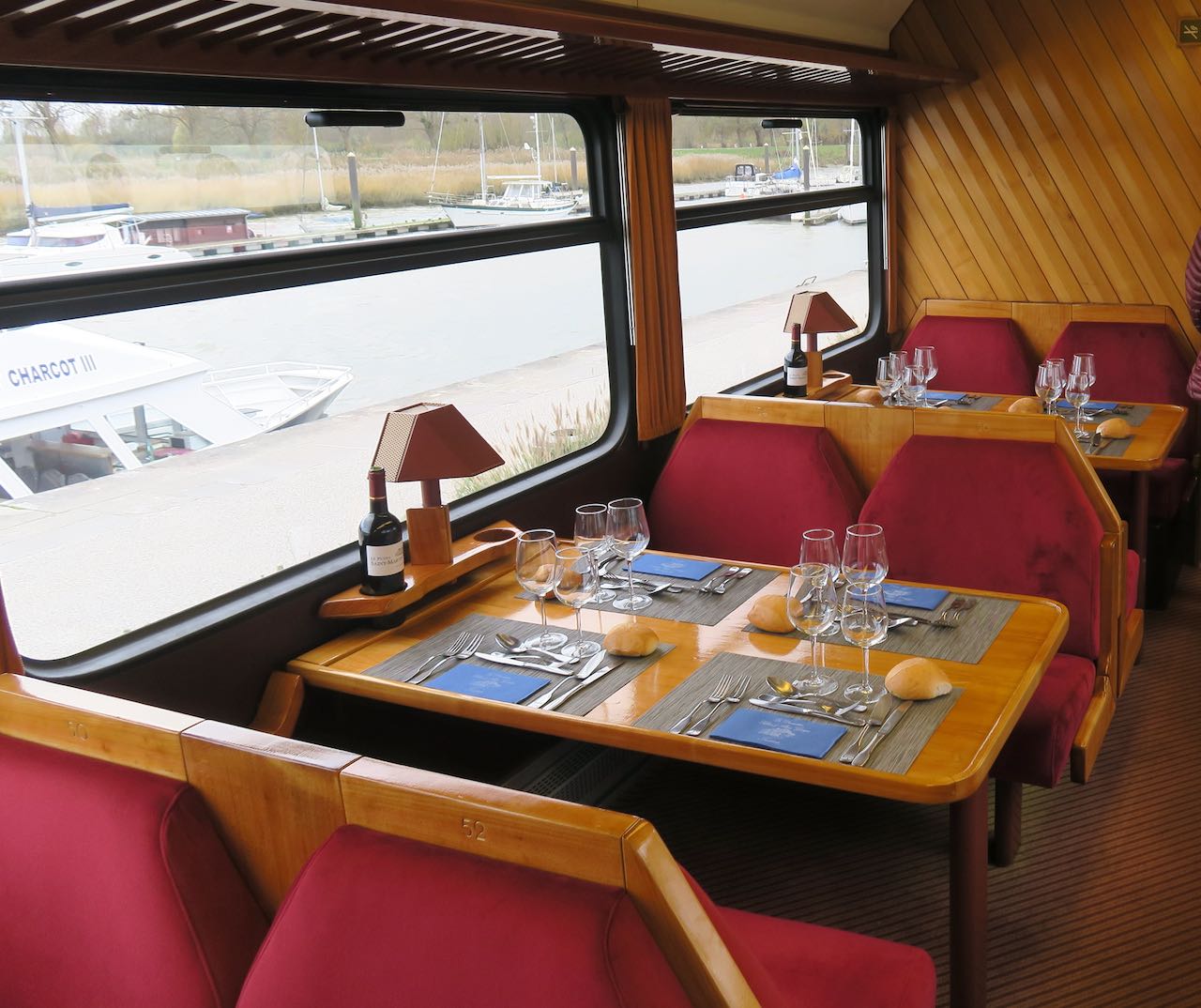
The CFBS has also acquired a number of open coaches from the RhB that can added to the dining train in modular form for a range of private and corporate events throughout the year. Above. With a hundred years difference between the locomotive and rolling stock CFBS Cail No.2 waits patiently to depart from St Valery Port while the Discours d'inauguration take place in the adjacent recently refurbished Entrepôt de Sels.
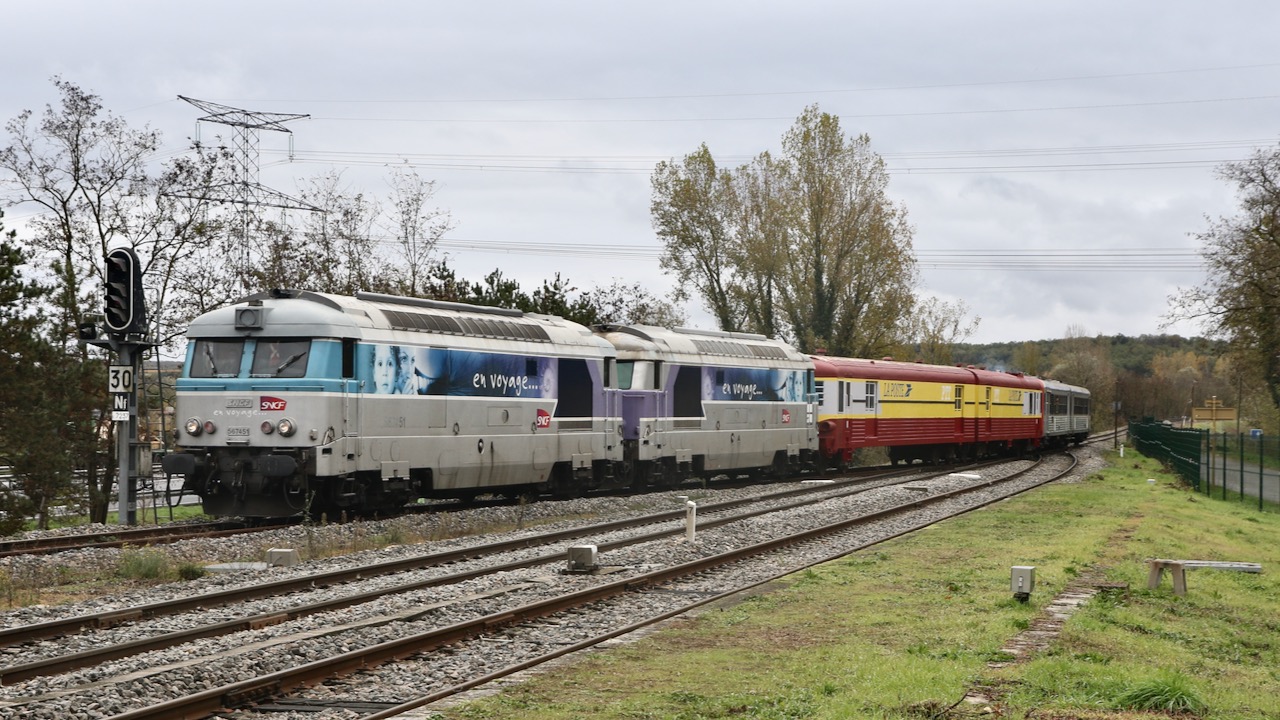
Postal Museum on the move
The Musée des Ambulants postaux de Toulouse is relocating from its former location at Raynal, adjacent to Toulouse Matabiau, to Gaillac. The Museum was created at Raynal in 1995 when mail ceased to be carried by rail (except by specially adapted TGVs) with the principal exhibits being the three postal vehicles in the opening photo and Rame Autotrice Postale X 94755, one of a small fleet of Caravelles converted to carry mail.
With the development of the Matabiau/Marengo areas of Toulouse as part of the Grand Matabiau Quai d’Oc project part of the land formally occupied by the Museum is being redeveloped as an approach road, and the Museum is moving to a new site at Gaillac station that will open in early 2025. The new museum at Gaillac will be developed jointly with the Musée Ferroviaire de St-Géry, who occupy the former goods shed and yard at St-Géry on the line from Cahors to Capdenac. The St-Géry Museum is short of space with many items in store, and has been looking for more space to increase their activities for some time, and concluded that developing a second site would be the best solution. The two museums have now signed a formal twinning accord and will develop the Gaillac site. More information at: http://www.ambulants.fr/bibliotheque/ProjetGaillac2023.pdf
On the 28th November the rolling stock from the Postal Museum was moved to Gaillac in two special trains. Above BB 67451/67573 are seen at Gragnague towing X 94755 and X 4647 belonging to CF Touristique du Sud des Ardennes (CFTSA), provided for braking capacity. At the very top of the page BB 67610 is seen with the three postal vehicles. Photos. Georges Turpin.
A1A A1A 62000s scrapped
The two A1A A1A 62000s that were formerly part of TVT (Train à Vapeur de Touraine) at Richelieu have been scrapped. After the trackbed from Chinon to Richelieu was converted into a cycleway it was hoped to move operations to Thouars but this failed to come to fruition. When TVT was wound up in 2016 most of the rolling stock was dispersed to other preservation groups, 62032 remained at Thouars and 62036 at Saumur, after it developed an axle problem whilst en route to Le Mans.
Opposite. 62036 in the yard at Saumur in August 2021, since the photo was taken its condition had deteriorated further through vandalism.

Urban Rail
Paris T12 tram-train open
Paris tram-train route T12 carried its first passengers on 10th December. Serving the southwestern suburbs, the 20.4km line runs partly over the former RER Line C between Massy-Palaiseau and Épinay-sur-Orge, then on 10km of new-built mainly on-street alignment to Évry-Courcouronnes. There are 16 stops including interchange with Lines B and V at Massy, Line C at Épinay, and Line E at Évry. Daytime service is half-hourly, increasing to every 12min at peak times. Some 40,000 daily journeys are expected.
Unusually, on the former Line C section T12 shares tracks with long-distance and freight trains; here maximum speed is 100km/h and cars run on the left as is standard on SNCF lines. On the new-built section, cars run on the right and are limited to 70km/h. Alstom has supplied 25 Citadis Dualis tram-trains; they run under 1.5kV DC power throughout.
T12 is operated by the Transkeo T12-T13 joint venture of Keolis (51%) and SNCF Voyageurs (49%), which is also responsible for maintaining the tramway section. The depot and control centre are located at Massy. Total cost of the project is €689 million.
The Line C stub from Massy-Palaiseau to Versailles-Chantiers has been rebranded as shuttle Line V. T12 is likely to be extended over this section in the future.
Île-de-France Mobilités President Valérie Pécresse and local officials open T12. Photo: Île-de-France Mobilités.
The Line C stub from Massy-Palaiseau to Versailles-Chantiers has been rebranded as shuttle Line V. T12 is likely to be extended over this section in the future.
Île-de-France Mobilités President Valérie Pécresse and local officials open T12. Photo: Île-de-France Mobilités.
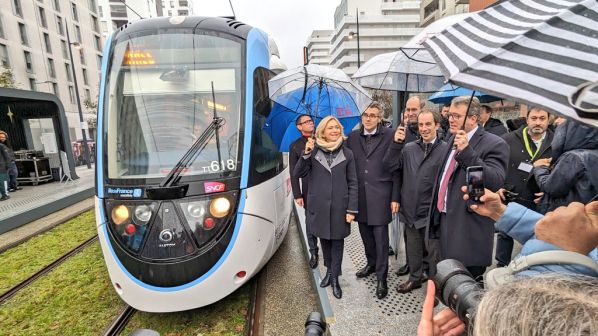
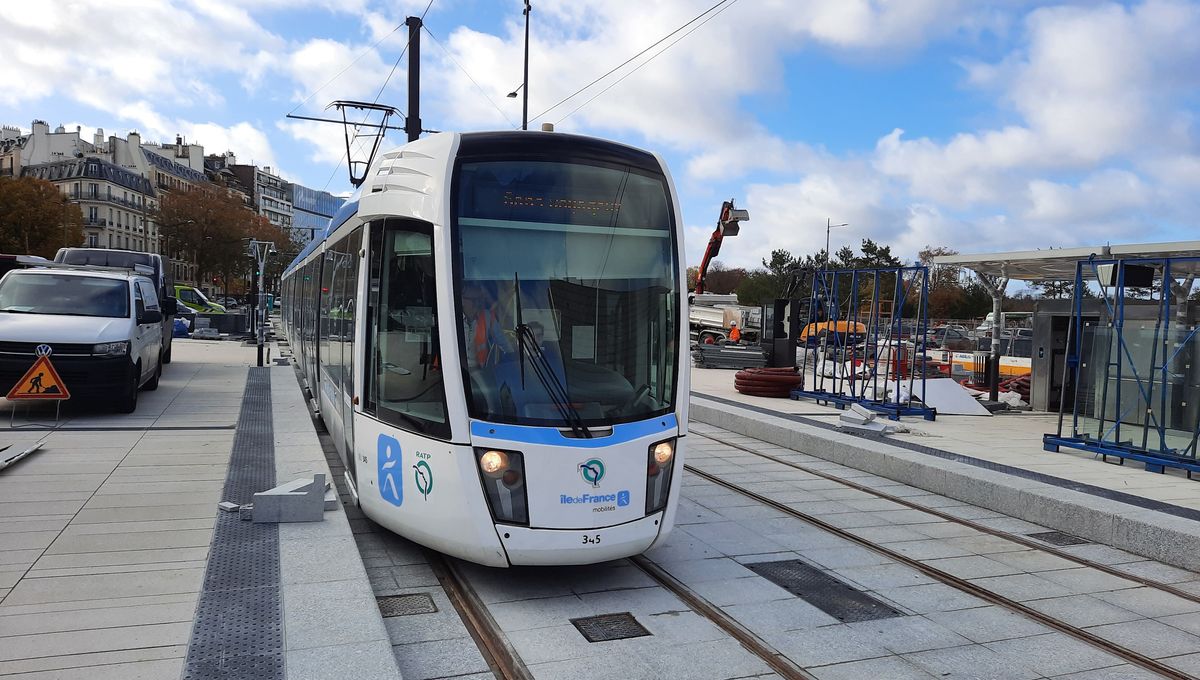
Paris GPE contracts. The Razel-Bec consortium has won the third construction contract for GPE Line 17, the section between Le Bourget Aéroport and Triangle de Gonesse, valued at €516 million. Also, Chantiers Moderne Construction will build and fit-out Gonesse station for €54 million. Specialist equipment manufacturer Novium is to supply 40 track maintenance machines for Lines 15, 16 and 17 for delivery between 2025 and 2030.
Alstom sued. Métropole européenne de Lille is taking legal action against Alstom following its withdrawal from mediation over late delivery of new cars and automated systems for Line 1 ordered in 2012 for 2016 delivery. Alstom expressed surprise, saying that it had ‘demonstrated the proper functioning of the system’ during the most recent trials. The manufacturer has already paid €53 million in penalties for the late-running contract which is unlikely to see the cars in operation before 2026.
Montpellier fares-free. From 21st December, public transport in Montpellier became fares-free in the latest move by Occitanie to encourage people out of their cars. At the same time, the région-wide TER tapering fares for 16 to 26 year-olds was extended to youngsters over 12.
Translation app. To help staff answer travel queries from visitors during the Olympic Games this summer, RATP has developed a phone app that will translate into French from 16 languages. It can also be used to give information in the six official Olympic languages in case of disruption or emergency.
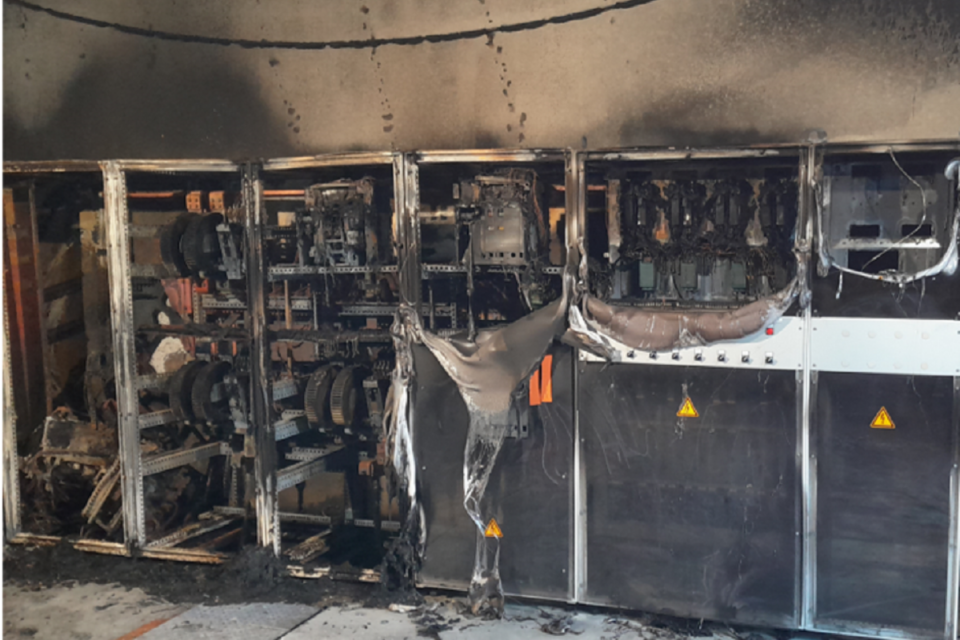
Rennes fire. On 18th November an electrical fire at Saint-Jacques-de-la-Lande depot destroyed all operating hardware for automated metro Line B, trapping trains and leading to the line’s total immobilisation. An emergency brake application that had occurred a few minutes before on a train at Cesson may have caused a short circuit that sparked the fire. Siemens staff worked with Keolis to build an entirely new electrical architecture and replace damaged systems and equipment. Substitute buses had a hard time coping with the displaced passengers, some 80,000 daily, and overworked drivers went on strike in mid-December. Line B service was eventually restored on 22nd December, with free travel offered on the entire network over the following weekend. Photo: Keolis.
Additions to FRS Photographic Archive during December 2023
To Locations section
Additions to the FRS public folder during December 2023
- Scanned and put on-line in the Public Folder all FRS Journals plus extra publications, as these appeared from June 1976 onwards. The accompanying index remains a work in progress but will be published as soon as possible.
© Peter Lovell & Chris Bushell. The French Railways Society 2024. With thanks to Georges Turpin, Christophe Masse, Christian Hospital and Jocelyne Bourneuf
